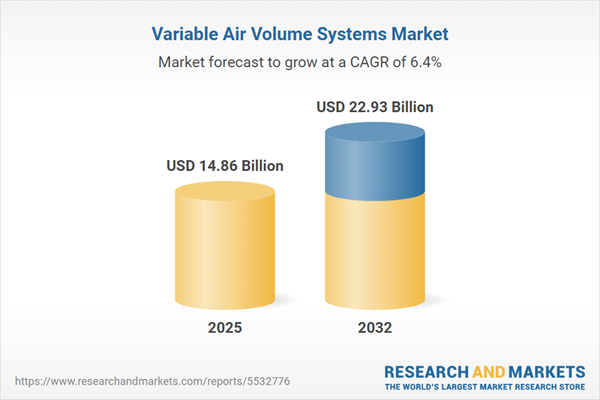Speak directly to the analyst to clarify any post sales queries you may have.
Variable Air Volume (VAV) systems are shaping the future of intelligent facility management by enabling increased adaptability, energy efficiency, and regulatory readiness for organizations seeking to optimize building operations. As precision climate control becomes central to modern infrastructure, VAV technologies deliver critical value across industries and geographies.
Market Snapshot: Variable Air Volume Systems Market
The Variable Air Volume Systems Market demonstrates steady growth, with a current value of USD 13.95 billion and a projected rise to USD 14.86 billion by 2025. Supported by a compound annual growth rate (CAGR) of 6.40%, adoption is driven by strong demand for energy-optimized HVAC solutions within commercial, healthcare, and technology-driven environments. Senior leaders are navigating evolving landscapes that call for increased digital integration, compliance with changing regulatory standards, and the ability to scale building management systems in line with facility-specific requirements. Progress in this market is determined by the alignment of advanced technology with strategies that anticipate and adapt to the evolving priorities of building owners and operators.
Scope & Segmentation of the Variable Air Volume Systems Market
This comprehensive report provides executive teams with targeted insights for informed decision-making on VAV adoption, deployment, and operational enhancements. Detailed segmentation supports targeted strategy development across all relevant facets, equipping organizations to maximize performance and resilience:
- System Types: Dual duct systems enhance building flexibility, fan-powered systems improve zone-level air distribution, and single duct systems offer simplified integration for specific operational needs across commercial and institutional settings.
- Zone Types: Core zone and perimeter zone approaches facilitate refined temperature control tailored to occupancy patterns and exposure to external environments.
- Control Types: Analog, digital, and smart controllers integrate with automation platforms to enable efficient monitoring and dynamic system adjustments across new and existing facilities.
- Airflow Range: High, medium, and low airflow options provide precise control over environmental quality and sustainability goals in diverse organizational spaces.
- End User Segments: Healthcare centers, data centers, educational campuses, hospitality venues, commercial offices, and retail environments each leverage customized VAV solutions to meet sector-specific compliance and performance objectives.
- Component Types: Electric and pneumatic actuators, advanced controllers, damper blades, and intelligent sensors serve as critical components for maintaining airflow consistency, streamlining diagnostics, and optimizing system reliability.
- Geographic Regions: The Americas, Europe, Middle East & Africa, and Asia-Pacific each present unique infrastructure and regulatory challenges, influencing adoption dynamics, compliance focus, and local investment priorities for VAV solutions.
- Key Companies: Major technology providers such as Johnson Controls, Honeywell, Schneider Electric, Siemens, ABB, Carrier, Trane Technologies, Daikin Industries, Mitsubishi Electric, and Toshiba continually strengthen innovation and expand global access.
Key Takeaways for Senior Leaders
- Next-generation VAV controls and adaptive sensors enhance system responsiveness, allowing organizations to seamlessly adjust to changing occupancy levels and minimize downtime.
- Continuous monitoring and predictive diagnostics support the protection of critical assets and ensure ongoing alignment with compliance standards in dynamic operational environments.
- Integration with IoT and building analytics enables organizations to track system performance transparently, simplify environmental reporting, and advance sustainability targets.
- Modular VAV design empowers facilities to address evolving regulatory requirements, sector-specific needs, and future expansion plans with minimized disruption.
- Improved system diagnostics and asset visibility facilitate data-driven capital planning and support risk mitigation strategies for long-term operational resilience.
- Regional priorities differ: European organizations emphasize modernization and retrofitting for existing infrastructure, while Asia-Pacific entities often focus on expanding capacity and aligning standards to accelerate adoption.
Tariff Impact and Supply Chain Response
Forthcoming US tariffs anticipated in 2025 are expected to impact sourcing for key components such as dampers and actuators. In response, organizations are diversifying their supplier base, establishing near-shoring initiatives, and negotiating longer-term material agreements. Procurement leaders are focusing on increasing transparency and building agile supply chain capabilities to adapt to emerging regulatory and market pressures in the Variable Air Volume Systems Market.
Methodology & Data Sources
This analysis draws on direct interviews with experienced industry executives, reinforced by verified secondary research, and is reviewed by subject matter experts. The resulting insights are actionable and designed to support successful strategic planning and implementation for VAV deployments.
Why This Report Matters
- Provides actionable guidance and proven decision-making frameworks to help leaders deploy VAV systems in complex operational environments.
- Enables organizations to advance digital transformation, reinforce compliance, and closely align operations with efficiency and sustainability imperatives.
- Links technology strategy directly with business resilience, ensuring that VAV investments contribute to measurable performance improvement and return on investment.
Conclusion
Senior leaders gain the clarity needed to drive successful Variable Air Volume system initiatives, optimize facility operations, and enhance readiness for emerging operational demands.
Additional Product Information:
- Purchase of this report includes 1 year online access with quarterly updates.
- This report can be updated on request. Please contact our Customer Experience team using the Ask a Question widget on our website.
Table of Contents
3. Executive Summary
4. Market Overview
7. Cumulative Impact of Artificial Intelligence 2025
Companies Mentioned
The companies profiled in this Variable Air Volume Systems market report include:- Johnson Controls International plc
- Honeywell International Inc.
- Schneider Electric SE
- Siemens AG
- ABB Ltd
- Carrier Global Corporation
- Trane Technologies plc
- Daikin Industries Ltd
- Mitsubishi Electric Corporation
- Toshiba Corporation
Table Information
| Report Attribute | Details |
|---|---|
| No. of Pages | 181 |
| Published | October 2025 |
| Forecast Period | 2025 - 2032 |
| Estimated Market Value ( USD | $ 14.86 Billion |
| Forecasted Market Value ( USD | $ 22.93 Billion |
| Compound Annual Growth Rate | 6.4% |
| Regions Covered | Global |
| No. of Companies Mentioned | 11 |









